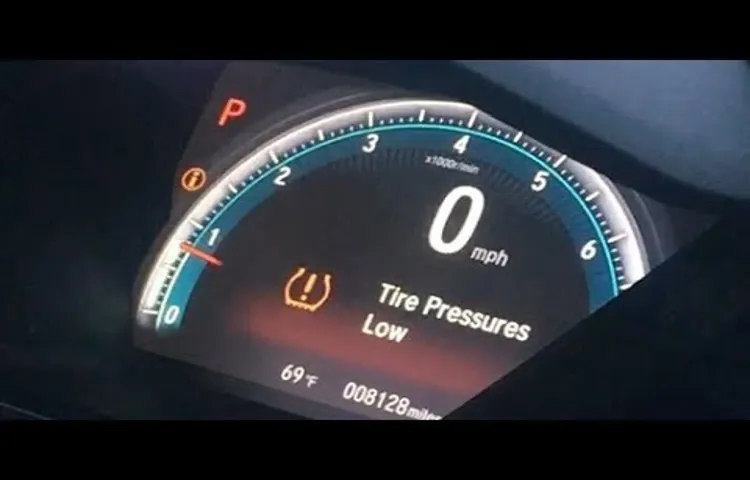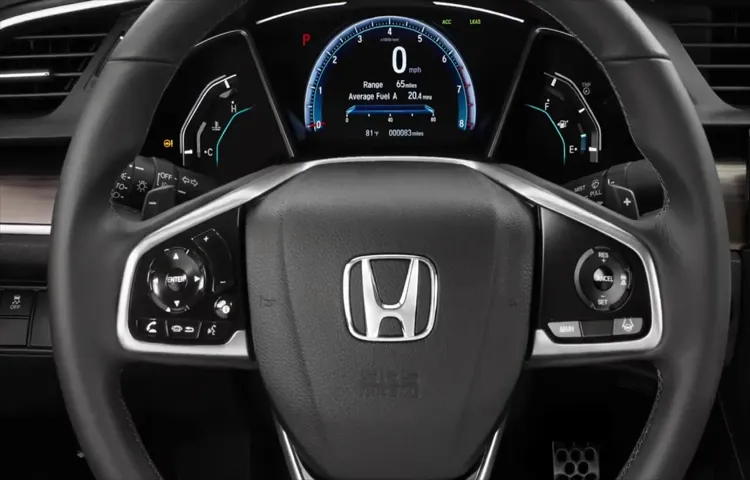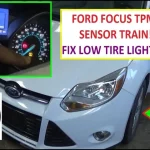Have you ever found yourself wondering if your tires are properly inflated? Wonder no more! Keeping your tire pressure at the correct level is essential for your car’s performance, longevity, and safety. In this blog, we will guide you on how to check tire pressure on Honda Civic 202 Whether you are a new driver or an experienced one, it is important to know the correct steps to ensure your tires are at the optimal pressure.
Checking your tire pressure may seem daunting, but it is a simple and quick task that you can do yourself with the right tools and knowledge. Let’s dive in and check the pressure of your Honda Civic 2021 tires.
Table of Contents
- 1 Why is Checking Tire Pressure Important?
- 2 Steps to Check Tire Pressure
- 2.1 – Gather necessary tools (gauge, valve cap, air compressor)
- 2.2 – Locate tire pressure information (in owner’s manual or on driver’s side door)
- 2.3 – Remove valve cap and place gauge on valve stem
- 2.4 – Read gauge and compare to recommended pressure
- 2.5 – Inflate or deflate tire as needed
- 2.6 – Repeat for all tires
- 3 Tips for Maintaining Proper Tire Pressure
- 4 Conclusion
- 5 FAQs
Why is Checking Tire Pressure Important?
If you’re wondering how to check tire pressure on a Honda Civic 2021, you’re not alone. Checking tire pressure is a crucial aspect of maintaining your vehicle’s safety and performance. Proper tire pressure helps ensure optimal gas mileage, minimizes wear and tear on your tires, and prevents blowouts or accidents on the road.
Thankfully, checking tire pressure is a simple process that you can do at home or at a gas station with a tire pressure gauge. First, locate the recommended tire pressure for your Honda Civic 2021 in the owner’s manual or the sticker on the driver’s side doorjamb. Then, use a tire pressure gauge to measure the PSI and compare it to the recommended pressure.
If the pressure is too low or too high, you can adjust it accordingly with an air compressor or by releasing air. Remember, regular tire pressure checks can save you money, extend your tire life, and keep you safe on the road.
– Improves fuel efficiency
One of the simplest and most effective ways to maintain your vehicle’s performance is by checking your tire pressure. Not only does it ensure the safety of your vehicle, but it also improves fuel efficiency and saves you money on gas. When your tires are underinflated, they have a larger area of the tire in contact with the road, increasing the rolling resistance.
This causes your engine to work harder and burn more fuel than necessary. On the other hand, overinflated tires can cause uneven wear and tear, leading to decreased traction and stability on the road. So, it’s important to regularly check your tire pressure and fill them up to the recommended PSI.
By doing so, you’ll not only increase your car’s fuel efficiency, but you’ll also extend the life of your tires and improve your overall driving experience.

– Increases tire lifespan
Checking tire pressure is an essential aspect of maintaining your vehicle. It is important for various reasons, including increasing the lifespan of your vehicle’s tires. When tires are underinflated, they are prone to wear out prematurely, reducing your tire’s lifespan and costing you more money in the long run.
On the other hand, overinflated tires can lead to uneven wear, making them unsafe for use on the roads. Therefore, it is crucial to ensure that your tires are inflated to the recommended pressure level by the vehicle manufacturer. Regular tire pressure checks not only save you money but also ensure you have a safe and smooth ride.
So, next time you’re out for a ride, be sure to check your tire pressure and make adjustments as necessary.
– Ensures safe driving experience
Maintaining adequate tire pressure is crucial for safe driving. It ensures that your tires have optimum contact with the road, reducing the risk of accidents caused by a sudden deflation or loss of traction on wet or uneven surfaces. Moreover, proper tire pressure can enhance fuel efficiency, extend tire life, and improve vehicle handling and braking.
Therefore, it is recommended to check your tire pressure regularly, ideally every month, or before embarking on a long journey. A simple tire gauge can do the trick, and you can find the recommended pressure levels in your car owner’s manual or on a sticker on the driver’s side door. Always keep in mind that underinflated or overinflated tires can have adverse effects on your safety and driving experience.
By taking care of your tire pressure, you can have peace of mind and a smooth ride on the road.
Steps to Check Tire Pressure
If you own a Honda Civic 2021, it’s important to keep an eye on your tire pressure. Proper tire pressure is crucial for your safety and the longevity of your tires. Luckily, checking your tire pressure is a quick and easy task that can be done in just a few simple steps.
To begin, you’ll need a tire pressure gauge, which can be purchased at any auto parts store. Once you have your gauge on hand, locate your vehicle’s recommended tire pressure in the owner’s manual or on the driver’s side door jamb. Next, remove the valve cap on one of your tires and press the gauge onto the valve stem.
The gauge will provide a reading of your tire’s pressure. If the pressure is too low, use an air compressor to add air until it reaches the recommended PSI. If it’s too high, use the gauge to release air until it’s at the correct level.
Repeat this process for each tire and remember to check your tire pressure regularly to ensure a safe and smooth ride on the road.
– Gather necessary tools (gauge, valve cap, air compressor)
Checking tire pressure is essential for ensuring a safe and smooth ride and can also enhance fuel efficiency and prolong the lifespan of your tires. But before proceeding with the check, you must gather the necessary tools such as a gauge, a valve cap, and an air compressor. Once you have everything ready, start by removing the valve cap and attaching the gauge to the valve stem.
Press the gauge firmly and consistently for at least 3-5 seconds and note the reading. Compare the reading with the manufacturer’s recommended tire pressure, which can be found in the owner’s manual or on the driver’s side door jamb. If the reading is low, use an air compressor to inflate the tire gradually, rechecking the pressure regularly until it reaches the optimal level.
On the other hand, if the pressure is too high, release some air with the valve stem until it reaches the optimum level. By regularly checking the tire pressure, you can stay safe on the road and save money in the long run.
– Locate tire pressure information (in owner’s manual or on driver’s side door)
Checking the tire pressure of your vehicle is an essential task that ensures your safety on the road and provides a smooth driving experience. To check your tire pressure, locate the tire pressure information in your owner’s manual or on the driver’s side door. It is important to check the pressure when the tires are cold, meaning they haven’t been used for more than an hour or have been driven for less than a mile.
To check the tire pressure, unscrew the valve cap and place a tire pressure gauge onto the valve stem. The gauge will provide you with the current tire pressure reading. If the reading is lower than the recommended pressure, add air until it reaches the appropriate level.
On the other hand, if the reading is higher, release air until it reaches the recommended level. Remember to always recheck the tire pressure and replace the valve cap once you’re finished. By following these simple steps, you can maintain the optimal tire pressure in your vehicle, which can increase fuel efficiency, prolong the life of your tires, and ensure your safety on the road.
– Remove valve cap and place gauge on valve stem
Checking your tire pressure is an essential part of your car maintenance routine, and it’s easy to do yourself. First, remove the valve cap on the tire you’re checking and place your gauge on the valve stem. You should hear a hiss as the gauge locks onto the valve stem.
Make sure the gauge is straight and not at an angle, as this can affect the reading. The pressure reading should appear on the gauge’s display. If the pressure is too high or low, adjust it accordingly.
Remember to check all four tires, including your spare tire, at least once a month. Keeping your tires at the recommended pressure not only ensures better gas mileage, but it also helps your tires last longer and can prevent accidents caused by under-inflated tires. Don’t forget to regularly check your tire pressure, so you can ride safely and smoothly on every journey.
– Read gauge and compare to recommended pressure
Checking tire pressure may seem like a small task, but it can make a big difference in your vehicle’s performance and safety. To check your tire pressure, first, you’ll need a tire pressure gauge. Simply remove the valve cap on the tire and press the gauge onto the valve stem.
You should hear a hissing sound, and the gauge will give you a reading of the tire pressure in psi (pounds per square inch). Compare this reading to the recommended pressure listed in your vehicle’s manual or on the tire placard located in the door jamb. If the pressure is too low, add air until you reach the recommended pressure.
If the pressure is too high, let some air out until you reach the recommended pressure. Regularly checking your tire pressure can improve fuel efficiency, extend tire life, and ensure a safer ride. So, remember to check your tire pressure at least once a month and before long road trips to keep your ride smooth and worry-free.
– Inflate or deflate tire as needed
Maintaining the proper tire pressure in your vehicle is vital to ensure that you have a safe and smooth ride. Checking the tire pressure is a straightforward process, and it’s crucial to do it regularly. The first step is to find the recommended tire pressure for your vehicle, which is usually found in the owner’s manual or on a sticker inside the driver’s door.
Once you know the correct pressure, use a tire pressure gauge to check the pressure of each tire. Simply remove the valve cap, press the gauge onto the valve stem, and read the pressure on the gauge. If the pressure is too low, add air until it reaches the recommended level.
If the pressure is too high, deflate the tire as needed. Remember to check the spare tire as well. Proper tire pressure not only ensures safety but can also improve gas mileage and prolong tire life.
So, take a few minutes every month to check your tire pressure and keep your vehicle in top shape for the road ahead.
– Repeat for all tires
When it comes to checking tire pressure, it’s important to follow a few easy steps to ensure that your tires are in good condition. First, remove the cap from the tire’s valve stem and use a tire pressure gauge to check the current pressure. If the pressure is too low, use an air compressor to inflate the tire and then re-check the pressure until it’s within the recommended range.
Repeat this process for all four tires, as each tire may have a different pressure level. By checking your tire pressure regularly, you can help improve your car’s fuel efficiency, prolong the life of your tires, and keep yourself safe on the road. So, take the time to follow these simple steps and keep your tires in tip-top shape!
Tips for Maintaining Proper Tire Pressure
Maintaining proper tire pressure is crucial when it comes to ensuring optimal performance and safety on the road. So, let’s discuss how to check tire pressure on your Honda Civic 202 First, locate the tire pressure monitoring system (TPMS) button on the dashboard and press and hold it until the display blinks.
Then, use a tire pressure gauge to check the pressure in each tire, making sure to match the recommended pressure in your owner’s manual. It’s a good idea to check your tire pressure at least once a month or before a long road trip. Maintaining proper tire pressure not only improves your car’s handling and fuel efficiency but also extends the lifespan of your tires.
Additionally, always inspect your tires for any signs of damage, such as cracks, bulges, or punctures, to ensure your safety while driving. So, take the necessary steps to maintain the proper tire pressure on your Honda Civic 2021, and enjoy a smooth and safe ride.
– Check tire pressure once a month
Tire pressure plays a vital role in determining your vehicle’s fuel efficiency, safety, and overall performance. One of the essential tips for maintaining proper tire pressure is to check it at least once a month. Underinflated tires can lead to increased fuel consumption, reduced traction, and a shorter lifespan, while overinflated tires can lead to poor handling and a bumpy ride.
To determine the ideal tire pressure, consult your vehicle owner’s manual or the tire manufacturer’s recommendations. You can use a tire pressure gauge to check the pressure accurately, and it’s recommended to do so when the tires are cold. With the right tire pressure, you can enjoy a smooth ride, better gas mileage, and increased safety on the road.
So, make it a habit to check your tire pressure regularly and keep your tires in top shape.
– Monitor pressure before long trips
Maintaining proper tire pressure is crucial for ensuring your vehicle’s safety and optimal performance on the road. One important tip is to regularly monitor tire pressure before long trips. Overinflated tires can be just as dangerous as underinflated ones, as they can cause the tires to burst under pressure.
On the other hand, underinflated tires can lead to poor handling, reduced fuel efficiency and increased wear and tear on tires, ultimately leading to costly replacements. A simple and easy way to check tire pressure is to use a tire pressure gauge, which can be purchased at any auto parts store. By using a tire pressure gauge, you can ensure that your tires are at the recommended PSI (per square inch) for your vehicle, maximizing both safety and performance.
So next time you plan a long road trip, don’t forget to check your tire pressure beforehand. Your vehicle – and your wallet – will thank you!
– Consider investing in a tire pressure monitoring system
Proper tire pressure is crucial for safe and efficient driving, and investing in a tire pressure monitoring system can help you maintain it. However, there are other tips you should keep in mind to ensure your tires stay properly inflated. First off, check your tire pressure regularly with a tire pressure gauge and adjust it according to your vehicle’s recommended specifications.
It’s also essential to ensure your tires are cold before checking the pressure, as heat can affect the readings. Additionally, make sure your tires are properly aligned and balanced to prevent uneven wear and tear. Neglecting proper tire maintenance can lead to decreased fuel efficiency, reduced tire lifespan, and even dangerous blowouts on the road.
So, don’t skimp on tire care – it’s a small investment of time and money that can make a big difference in your driving experience.
Conclusion
In the immortal words of Shakespeare, “To inflate or not to inflate, that is the question.” Well, the answer is definitely to inflate, and to do so regularly. Checking your tire pressure on a Honda Civic 2021 is a simple task that anyone can do.
All you need is a tire pressure gauge and a few minutes of your time. By keeping your tires properly inflated, you’ll not only save money on gas and extend the life of your tires, but you’ll also have a smoother and safer ride. So, don’t be a deflated Debbie Downer, give your tires a little TLC and hit the road with confidence!”
FAQs
What is the recommended tire pressure for Honda Civic 2021?
The recommended tire pressure for Honda Civic 2021 is 32 PSI in the front tires and 30 PSI in the rear tires.
How often should I check the tire pressure on my Honda Civic 2021?
You should check the tire pressure on your Honda Civic 2021 at least once a month or before long trips.
Can I use the tire pressure monitoring system (TPMS) to check my tire pressure?
Yes, the TPMS can display the tire pressure of each tire on your Honda Civic 2021, but it is still recommended to use a tire pressure gauge for accuracy.
What should I do if the tire pressure is too low on my Honda Civic 2021?
You should add air to the tires to reach the recommended tire pressure. Make sure to check the tire pressure again after adding air.
What should I do if the tire pressure is too high on my Honda Civic 2021?
You should release air from the tires until they reach the recommended tire pressure. Make sure to check the tire pressure again after releasing air.
Can a low tire pressure affect the fuel efficiency of my Honda Civic 2021?
Yes, a low tire pressure can reduce the fuel efficiency of your Honda Civic 2021 because it increases the rolling resistance of the tires.
How can I maintain proper tire pressure on my Honda Civic 2021?
You can maintain proper tire pressure on your Honda Civic 2021 by checking the tire pressure regularly, keeping the tires properly inflated, and avoiding overloading the vehicle.



